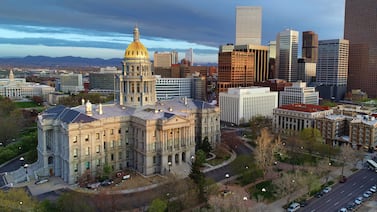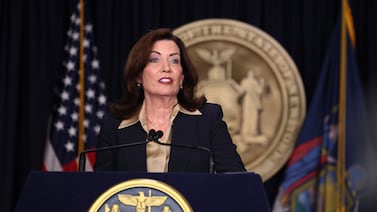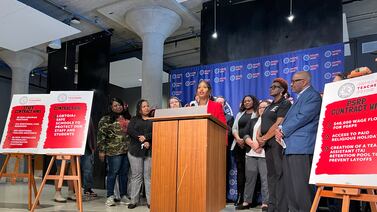The number of kids grabbing free meals from the San Luis Coastal Unified district is rising.
Before the pandemic, the district of 7,700 on California’s Central Coast served breakfast and lunch to around a quarter of its students each day. But that percentage shot up during the pandemic, when schools nationwide could give free meals to all kids. And it rose again last year, when California launched the nation’s first statewide free school meals program.
Today, between 50% and 60% of students in the district eat free breakfast and lunch each day. That includes students whose families could afford to pay before, and some students whose families struggled financially but “may not appear most vulnerable on paper,” said Erin Primer, the district’s director of food and nutritional services.
It’s a huge relief, Primer said, “to know that those families are taken care of, that I don’t have to get a call from the single mom who missed qualifying by $200.”
What’s happening in Primer’s district is likely to play out in many more schools across the country as several states prepare to launch their own universal meals programs this fall. Nine states will offer free breakfast and lunch to all their students this school year — a notable shift given that no state did so before the pandemic.
While lawmakers in several states have pushed back on the idea, arguing the cost is too high and that families who can afford meals should pay for them, more states are considering such proposals.
“There is a tremendous amount of momentum,” said Crystal FitzSimons, who oversees school nutrition work for the nonprofit Food Research & Action Center. “People didn’t want to go back to the way the program operated before, with lots of kids whose families are struggling not being eligible for free meals, unpaid school meal debt, and too much administrative work.”
Why states are launching universal school meal programs
Before COVID, a growing number of schools offered free breakfast and lunch to all their students through a federal program meant to help high-poverty schools. In 2019, just under 15 million students attended schools that served free meals through this program, or around 30% of public school children.
But when the pandemic hit, federal officials gave all schools permission to serve free breakfast and lunch to all their students, regardless of families’ incomes. Many states found they liked the reduced paperwork for families and school staff, as well as the diminished stigma for students who ate the meals, since no one could tell which children came from low-income families.
There are other benefits. Past research has shown that serving free school meals to all kids can help families save money on grocery bills and reduce school suspensions. In some cases, it’s also been linked to higher student attendance rates and improvements in test scores.
But that federal permission expired last year, driven in part by congressional Republicans’ concerns about its cost. Similarly, some state lawmakers have stressed that schools have limited resources. They’ve also raised philosophical questions.
“Presumably we espouse individual responsibility,” North Dakota Sen. Michael Wobbema, a Republican, said earlier this year as the state debated whether it should cover the reduced-price copay for school meals. “And at what point in time do we just wave that away and make the state responsible?”
In North Carolina, when Marianne Weant has advocated for universal free school meals with the North Carolina Alliance for Health, fiscally conservative lawmakers on both sides of the aisle have expressed similar concerns.
“We hear a lot: We don’t want rich kids to get a free meal,” she said. To that she replies: “Kids are kids, they forget their lunch sometimes.”
Another argument she’s used: Schools don’t charge kids for other essentials, like textbooks and laptops. “No one asks your mom if they make too much to ride the bus,” Weant added.
But the 2022 shift at the federal level prompted other states to pass laws to keep school breakfast and lunch free.
California and Maine were the first to do so, followed by — in chronological order — Colorado, Minnesota, New Mexico, Vermont, Michigan, and Massachusetts. Colorado, notably, put the question to voters, who overwhelmingly said “yes.” Nevada, meanwhile, will use federal COVID relief funds to offer free meals on a temporary basis again this year.
Others may join them. Lawmakers in Illinois approved a universal school meals program in June that the governor is expected to sign soon.
One of the biggest draws of universal free meal programs is that they often increase the number of students who eat breakfast and lunch.
That seems to be happening in California. Last school year, California schools were on track to serve more breakfasts and lunches than they had the prior year, according to state data through April.
Several big California districts, like Los Angeles and Fresno Unified, saw increases in students eating breakfast and smaller upticks in students eating lunch last year, a recent survey by FitzSimons’ organization found — while large districts in other states without free meals saw declines as they returned to charging students.
Kim Frinzell, who directs nutrition services for California’s education department, said schools have reported that increase has come from both families that could pay, and students who qualified for discounted — but not free — meals in the past.
“You talk to people out in the community and it’s like: It’s so great I don’t have to worry about my child having to have money in their account or packing a lunch,” Frinzell said.
In the Sacramento City Unified district, middle-class parents who didn’t qualify for free meals before have said the money they are saving on groceries has helped them save for emergencies or afford other school activities for their kids, like field trips.
“For them to have two meals per day at school makes a huge difference for me,” Sara Goncalves, a teacher’s aide with two children in the district, told the Sacramento Bee this spring.
When more students eat school meals, districts also get more money back from the federal government. That’s allowed Primer in San Luis Coastal Unified to use higher-quality ingredients and a wider variety of popular foods, from blocks of cheese from a local creamery to short ribs from a nearby ranch.
Teachers and principals have told Primer that’s helped improve school attendance in some cases. At the district’s high school for students who are at risk of not graduating on time, for example, the addition of a chicken tamale dish to the menu motivated one student who struggled to come to school to keep showing up.
Just outside of Portland, Maine, the nutrition services director at Westbrook schools, Mary Emerson, has observed something similar. The uptick in meals her district serves has meant she can afford to offer more Halal options — the district serves many immigrant families from Africa and the Middle East — and higher-quality items that kids love, such as all-Maine fish sticks.
Her cafeteria lines are also running more smoothly, now that elementary schoolers aren’t punching in a five-digit code to get free meals. And she no longer has to spend time calling parents to say “oh, you owe $20.”
“I love it,” Emerson said.
Ultimately, some say a divide between states that do and don’t offer universal free school meals will likely remain unless Congress takes broader action.
“The school nutrition programs are national programs,” FitzSimons said. “Kids in Mississippi and South Dakota should have just as much access to school meals as kids who are in Maine and Colorado and California.”
Kalyn Belsha is a senior national education reporter based in Chicago. Contact her at kbelsha@chalkbeat.org.







